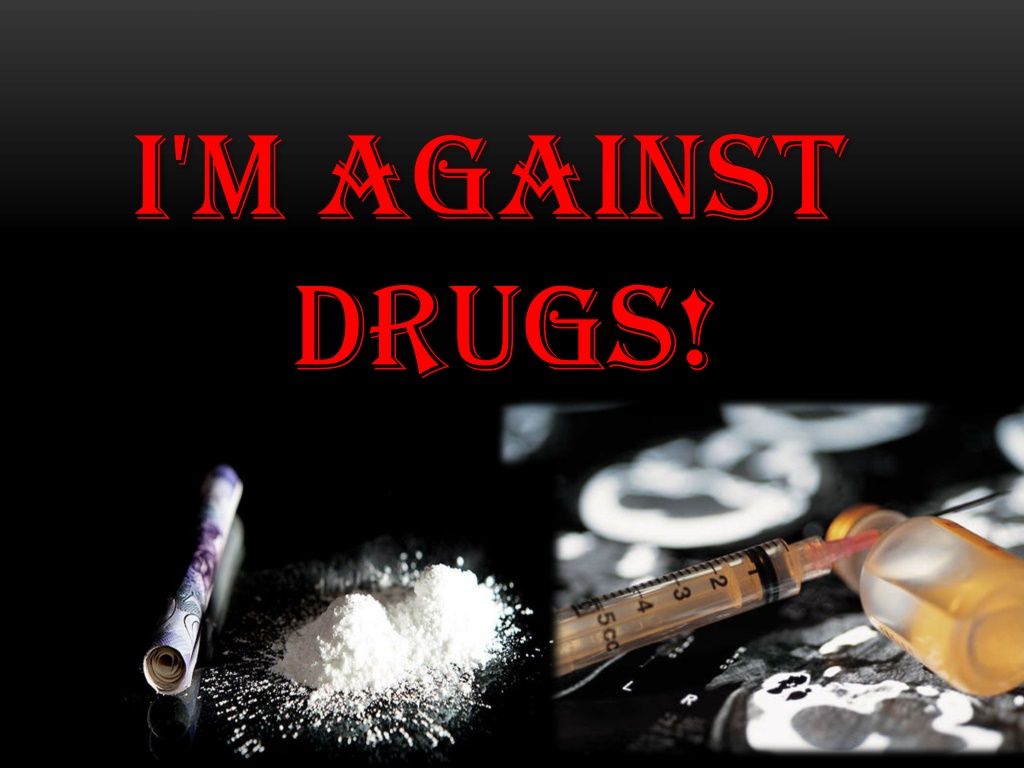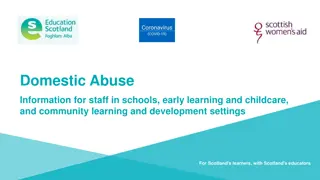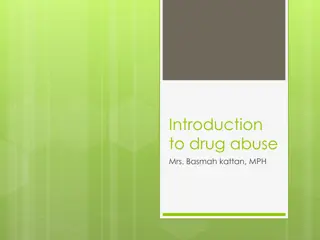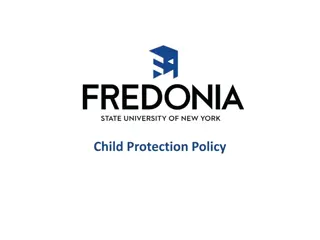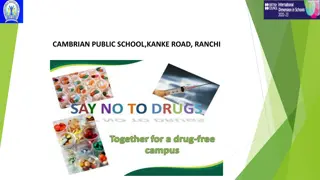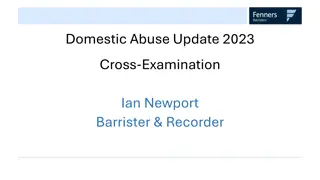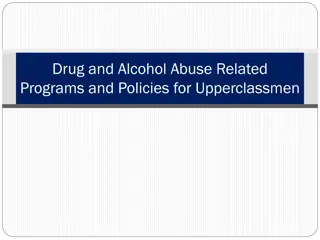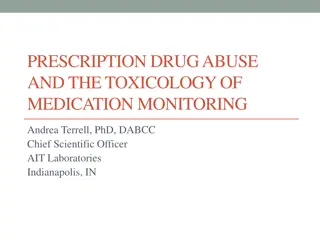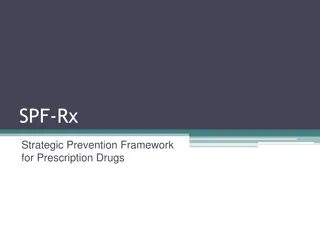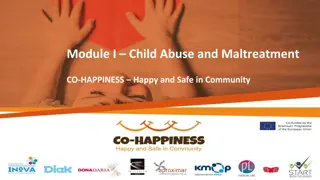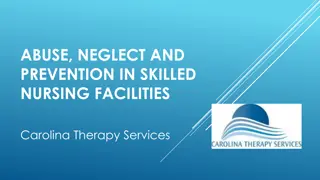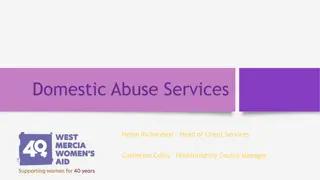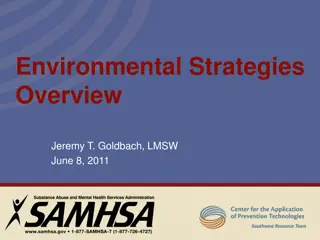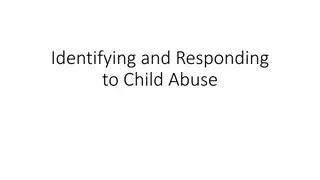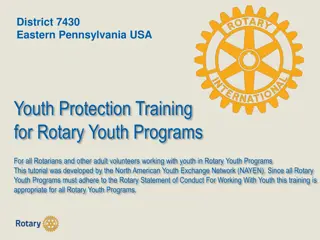Understanding the Impact of Drug Abuse on Youth
Drug abuse among youth is a growing concern with more individuals turning to psychoactive substances to alter their feelings and behaviors. This abuse of drugs, including amphetamines, marijuana, and heroin, can lead to irreversible changes in the brain and loss of self-control. Factors like the desire to escape reality and peer influence contribute to the rise in drug use among teenagers, highlighting the need for awareness and prevention strategies. Statistics reveal a worrying trend of increased drug experimentation among teenagers, emphasizing the urgency to address this issue effectively.
Download Presentation

Please find below an Image/Link to download the presentation.
The content on the website is provided AS IS for your information and personal use only. It may not be sold, licensed, or shared on other websites without obtaining consent from the author. Download presentation by click this link. If you encounter any issues during the download, it is possible that the publisher has removed the file from their server.
E N D
Presentation Transcript
I'm against drugs!
More people are abusing More people are abusing drugs today than in any drugs today than in any other time in history of other time in history of mankind, and many of mankind, and many of those people are youth. those people are youth.
Understanding what drugs are is fundamental for understanding their potential abuse. Drugs are a psychoactive substance. A psychoactive substance is something that people take to change the way they feel, think or behave. Some of these substances are called drugs and others, like alcohol and tobacco, are considered dangerous, but are not called drugs. The term drug also covers a number of substances that must be used under medical supervision to treat illnesses.
A drug is considered to be any chemical that is not food though affects your body. There are such drugs as medicines and painkillers which are prescribed by a doctor and are available in pharmacies but the other type which is man-made is really dangerous. These include amphetamines, anabolic steroids, marijuana, inhalants, cocaine and heroin. They cause irreversible changes in a person s brain and very often lead to losing the feeling of self control and the ability to understand anything. It s an absurd that nowadays people invent drugs in huge quantities especially for human consumption.
Its hard to say why people start taking drugs. One of the main reasons, probably, is the desire to escape the reality. They try to change the way they feel, think or behave. However, everything that happens after taking drugs is just a miracle. There aren t any factors that are able to predict whether a person will become addicted but very often the risk is influenced by a person s biology, social environment and stage of development.
Statistics show that drug use by teenagers has doubled since 1999. Half teenagers who were interviewed admitted they had tried at least one type of drug. 70 % said they had been offered drugs in the past 3 months. 31 % of interviewed teenagers could not name a health risk associated with Ecstasy. 49 % of young drug-users say they would stop using drugs if they thought they were getting addicted. 35 % of young drug-users say they don't know why they use them. MOST young drug-users say that they listen more to what their friends say about drugs than to what the media say about drugs. THE NUMBER of young males taking drugs is higher than the number of young females
Painkillers, Narcotic Abuse, and Addiction One of the most frequent reasons people go to the doctor is for pain relief. There are a number of different drugs that can ease pain. Opioids -- also called opiates or narcotics -- are pain relievers made from opium, which comes from the poppy plant. Morphine and codeine are the two natural products of opium. Synthetic modifications or imitations of morphine produce the other opioids: Heroin (street drug) Dilaudid (hydromorphone) Percocet, Percodan, OxyContin (oxycodone) Vicodin, Lorcet, Lortab (hydrocodone) Demerol (pethidine) Methadone Duragesic (fentanyl)
People of all ages abuse prescription drugs for a number of reasons, including: To feel good or get high To relax or relieve tension (painkillers and tranquilizers) To reduce appetite (stimulants) To experiment To be accepted by peers (peer pressure) or to be social To be safe it's a false belief that prescription drugs are safer than street drugs To be legal it's a mistaken thought that taking prescription drugs without a prescription is legal To feed an addiction
What Are Prescription Pain Relievers? Prescription pain relievers include the opioid class of drugs, such as hydrocodone (i.e., Vicodin), oxycodone (i.e., OxyContin), morphine, fentanyl and codeine. Opioids work by mimicking the body s natural pain-relieving chemicals, attaching to receptors in the brain to block the perception of pain. Opioids can produce drowsiness, nausea, constipation, and slow breathing. Opioids also can induce euphoria by affecting the brain regions that mediate what we perceive as pleasure. Dangers when abused: Highly addictive Can slow one s breathing to dangerous levels, including accidental overdose Particularly dangerous when used in combination with alcohol
What Are Tranquilizers and Sedatives? Tranquilizers and sedatives are central nervous system depressants, such as Xanax, Valium, and Librium, which are often prescribed to treat anxiety, panic attacks and sleep disorders. Central nervous system depressants, known as barbiturates and benzodiazepines, slow normal brain function to produce a drowsy or calming effect. Dangers when abused: Can slow breathing and heartbeat, especially if combined with other prescriptions, alcohol, or over-the-counter (OTC) cold and allergy medications Can lead to withdrawal and seizures when discontinued after prolonged use
What Are Stimulants? Stimulants such as Ritalin, Adderall and Dexedrine increase alertness, attention and energy and are often prescribed for health conditions such as attention-deficit/hyperactivity disorder, narcolepsy and depression. Stimulants enhance the effects of norepinephrine and dopamine in the brain, increase blood pressure and heart rate, constrict blood vessels, and open up the pathways of the respiratory system. They can also produce a sense of euphoria. Dangers when abused: Addictive Can create extremely high body temperature Can cause seizures/irregular heartbeat
Recognizing prescription drug abuse, symptoms include: Stealing, forging or selling prescriptions Taking higher doses than prescribed Excessive mood swings Increase or decrease in sleep Poor decision-making Appearing to be high, unusually energetic or revved up, or sedated Continually "losing" prescriptions, so more prescriptions must be written Seeking prescriptions from more than one doctor
Administration of drugs Bolus is the administration of a medication, drug or other compound that is given to raise its concentration in blood to an effective level. The administration can be given intravenously, by intramuscular, intrathecal or subcutaneous injection. Inhaled, (breathed into the lungs), as an aerosol or dry powder. (This includes smoking a substance) Injected as a solution, suspension or emulsion either: intramuscular, intravenous, intraperitoneal, intraosseous. Insufflation, or snorted into the nose. Orally, as a liquid or solid, that is absorbed through the intestines. Rectally as a suppository, that is absorbed by the rectum or colon. Sublingually, diffusing into the blood through tissues under the tongue. Topically, usually as a cream or ointment. A drug administered in this manner may be given to act locally or systemically. Vaginally as a pessary, primarily to treat vaginal infections.
Control of drugs There are numerous governmental offices in many countries that deal with the control and oversee of drug manufacture and use, and the implementation of various drug laws. The Single Convention on Narcotic Drugs is an international treaty brought about in 1961 to prohibit the use of narcotics save for those used in medical research and treatment. In 1971 a second treaty the Convention on Psychotropic Substances had to be introduced to deal with newer recreational psychoactive and psychedelic drugs. The legal status of Salvia divinorum varies in many countries and even in states within the United States. Where it is legislated against the degree of prohibition also varies. The Food and Drug Administration (FDA) in the United States is a federal agency responsible for protecting and promoting public health through the regulation and supervision of food safety, tobacco products, dietary supplements, prescription and over- the-counter medications, vaccines, biopharmaceuticals, blood transfusions, medical devices, electromagnetic radiation emitting devices, cosmetics, animal foods[34] and veterinary drugs.
Famous people Famous people who who used the used the drugs drugs:
Gia Marie Carangi 21.11.1986
Freddie Mercury 24.11.1991
Rudolf Nureyev 1993
Kurt Cobain 08.04.1994
Janis Joplin January 1971
Jimi Hendrix 18.09.1970
Thanks for watching Thanks for watching
